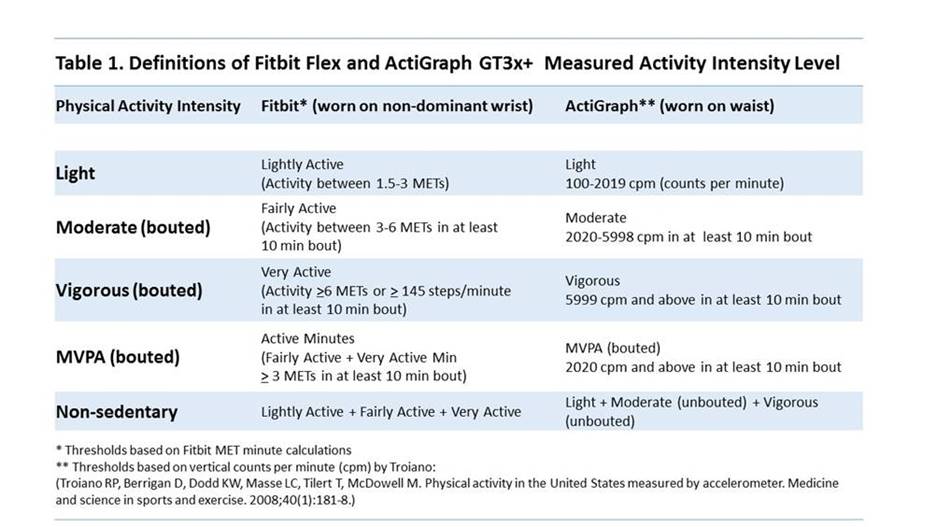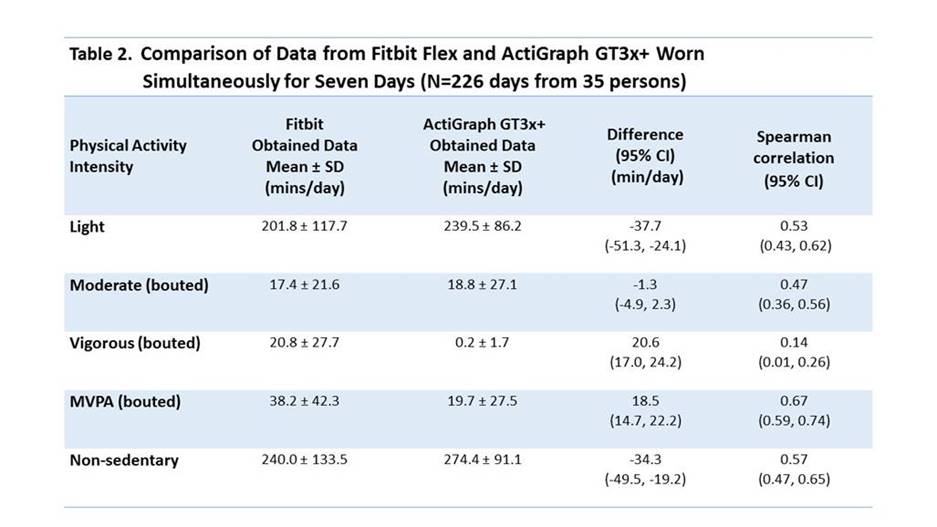Session Information
Date: Sunday, October 21, 2018
Title: Orthopedics, Low Back Pain and Rehabilitation Poster – ACR/ARHP
Session Type: ACR/ARHP Combined Abstract Session
Session Time: 9:00AM-11:00AM
Background/Purpose: There is increasing public health interest in the objective measurement of free-living physical activity in persons with arthritis, but research grade wearable monitors can be expensive. We therefore sought to examine the accuracy of the affordable personal monitor (Fitbit Flex) by comparing that output with data from the GT3X+ accelerometer (amount of time spent in light, moderate, and vigorous PA) worn simultaneously for 7 days; high accuracy would support substitution with this less expensive personal activity monitor in future arthritis research.
Methods: Subjects (n=35) with chronic knee symptoms were recruited for a pilot intervention study using Fitbits to increase physical activity in employees with chronic knee symptoms at an urban insurance corporation. Subjects simultaneously wore for 7 days a Fitbit Flex (wrist-worn) and ActiGraph GT3x+ (waist-worn) as part of 12-week post-intervention follow-up evaluation. Fitbit Flex data was regularly stored on a research storage service (Fitabase) by participants. Correlation tables were constructed to examine the association between the amount of time spent in activity intensity categories (Light, Moderate, Vigorous, and Moderate/Vigorous – the last three categories in bouts of 10 min or more). Due to discrepancy in wear time (Fitbit worn for 24 hours/day, ActiGraph unit was not), sedentary minutes were not included for comparison. Comparisons were calculated by matching Fitabase data from calendar days Fitbit was worn with data from valid monitoring days (≥10 hours wear time) of the ActiGraph.
Results: Participants at baseline were primarily female (69%), Caucasian (57%), with mean age 52 years, BMI 32 kg/m2. Table I provides an overview of the definitions and distinctions of each measured activity intensity level. Table 2 provides the comparison of data from Fitbit Flex and ActiGraph GT3x+, including Spearman correlations, within each of the activity intensity categories.
Conclusion: The individual intensity category correlations for the two devices are not strong. However, the bouted Moderate-Vigorous activity categories are moderately well correlated. One potential confounder includes the wrist vs waist location of the monitoring device during data collection. This moderate correlation of moderate/vigorous intensity between devices is reassuring to consumers/researchers using the Fitbit to track bouted higher intensity activities, but may not support substitution of the ActiGraph with the Fitbit in population studies that seek to accurately measure all levels of activity and sedentary time.
To cite this abstract in AMA style:
Semanik P, Lee J, PELLEGRINI C, Song J, Dunlop DD, Chang RW. Comparison of Physical Activity Measures Derived from the Fitbit Flex and the Actigraph GT3x+ in an Employee Population with Chronic Knee Symptoms [abstract]. Arthritis Rheumatol. 2018; 70 (suppl 9). https://acrabstracts.org/abstract/comparison-of-physical-activity-measures-derived-from-the-fitbit-flex-and-the-actigraph-gt3x-in-an-employee-population-with-chronic-knee-symptoms/. Accessed .« Back to 2018 ACR/ARHP Annual Meeting
ACR Meeting Abstracts - https://acrabstracts.org/abstract/comparison-of-physical-activity-measures-derived-from-the-fitbit-flex-and-the-actigraph-gt3x-in-an-employee-population-with-chronic-knee-symptoms/


